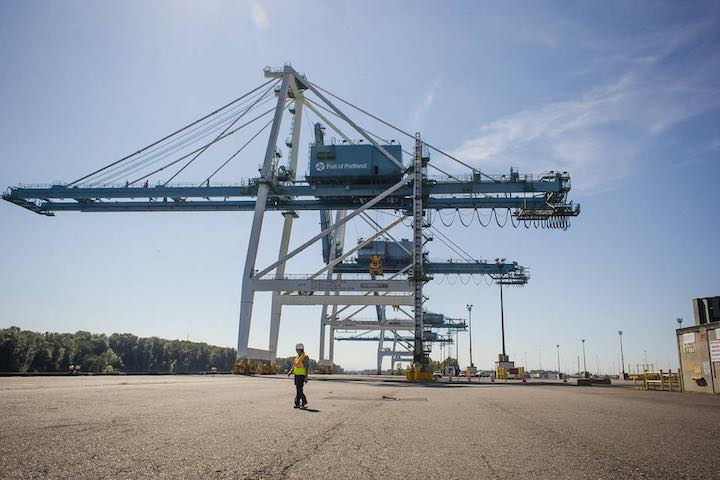forum
library
tutorial
contact

Port of Portland Faces Challenges,
Opportunities, Director says in Albany Visit
by Alex Paul
Albany Democrat-Herald, May 30, 2016
|
the film forum library tutorial contact |

|
Port of Portland Faces Challenges,
by Alex Paul
|
Now, many businesses are trucking their loads to Northwest Container, a reloading center
in Portland, where the containers are taken by rail to ports in Tacoma or Seattle.
 Although the international container shipping business has been important to the Port of Portland for the last 40 years, changes within the industry -- such as huge ships that can carry up to 20,000 containers -- pose big questions for the future, the port's executive director, Bill Wyatt, said Thursday during a visit to Albany.
Although the international container shipping business has been important to the Port of Portland for the last 40 years, changes within the industry -- such as huge ships that can carry up to 20,000 containers -- pose big questions for the future, the port's executive director, Bill Wyatt, said Thursday during a visit to Albany.
Wyatt and other port officials, Deputy Director Curtis Reinhold and Communications Director Martha Richmond, were in town to speak with mid-valley port customers at the Linn County Fair & Expo Center.
Their message was twofold: To talk about the port's 125-year history and to update shippers on issues surrounding Terminal 6, which was ground zero last year in a battle between the International Longshoreman and Warehouse Union and International Container Terminal Services, Inc., which operates the terminal on a lease basis.
Wyatt said the lease is worth $4.5 million per year to the port, out of a total annual budget of about $280 million.
"We are called the Port of Portland, but all parts of the state are affected," he said.
Wyatt said last year's work slowdown by longshoremen caused huge problems for shipping, including the compressed hay companies in the mid-valley.
Wyatt said container shipping began to take shape in the 1970s, when companies recognized it took much less time to unload containers at a port than individual items loaded onto pallets. Containers eventually became a standard size: 8 feet tall, 8 feet wide and 20- and 40-feet long.
But the port of Portland also imports and exports many other goods, including Toyota, Ford and Hyundai automobiles; Columbia Sports Wear; agricultural products such as pot ash and soda ash; wheat, corn and soybeans; and even scrap metal.
All three shippers, Hanjin, Hapag-Lloyd and Westbrook Shipping Lines, have ceased operations through Terminal 6. Hanjin had accounted for about 80 percent of the port's container business and Hapag-Lloyd carried about 20 percent. Westbrook was down to about one ship per month.
Now, many businesses are trucking their loads to Northwest Container, a reloading center in Portland, where the containers are taken by rail to ports in Tacoma or Seattle.
But the port has other issues, in terms of being able to service the larger container ships. Many have too much draft -- the port can handle only up to 43 feet of draft -- and others are too tall for the cranes, which cost $10 million each, that are in place at the port.
The port is working on three key areas to mitigate the Terminal 6 issues:
Wyatt has headed the port for 15 years and said he doesn't see how a proposal by former legislator Kevin Mannix, for the state to take over ownership of the terminal by a proposed Oregon Shipping Authority, would work.
According to Wyatt, such an arrangement would not likely be accepted by the unions or shipping lines that deal with them through collective bargaining contracts.
But Mannix contends that the port has "failed miserably" in developing new container shipping traffic, down from 339,571 units to zero today.
"The Port of Portland has managed to pull off this disaster despite the completion in 2010 of a billion dollar taxpayer-funded dredging designed to ensure the passage of ships all the way up the Columbia River to Portland," Mannix said in a letter to Oregon Shipping Authority proponents.
Portland International Airport is a major component of the port system, with more than 18 million passenger visits in 2015 -- more than 615,000 of them coming from Linn and Benton counties. The port includes the Troutdale and Hillsboro airports as well.
"Jet fuel prices are down and have stabilized," Wyatt said. "Air travel reflects local economics, and with a 5 percent unemployment rate, things are looking good for much of Oregon. Airlines have seen 8 to 10 percent annual growth in recent years."
Wyatt said that in 2001, there was one international flight per day out of Portland and today, there are more than 10, taking passengers to places like Japan, Germany, Mexico and Iceland.
Related Pages:
Shipping Authority Seeks to 'Adopt' Portland by Staff, Port Strategy, 5/12/16
Here's Why Portland Won't Get New Shipping Container Service Anytime Soon by James Cronin, Portland Business Journal, 5/9/16
learn more on topics covered in the film
see the video
read the script
learn the songs
discussion forum
